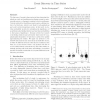Free Online Productivity Tools
i2Speak
i2Symbol
i2OCR
iTex2Img
iWeb2Print
iWeb2Shot
i2Type
iPdf2Split
iPdf2Merge
i2Bopomofo
i2Arabic
i2Style
i2Image
i2PDF
iLatex2Rtf
Sci2ools
81
Voted
SDM
2009
SIAM
2009
SIAM
Event Discovery in Time Series.
The discovery of events in time series can have important implications, such as identifying microlensing events in astronomical surveys, or changes in a patient’s electrocardiogram. Current methods for identifying events require a sliding window of a fixed size, which is not ideal for all applications and could overlook important events. In this work, we develop probability models for calculating the significance of an arbitrary-sized sliding window and use these probabilities to find areas of significance. Because a brute force search of all sliding windows and all window sizes would be computationally intractable, we introduce a method for quickly approximating the results. We apply our method to over 100,000 astronomical time series from the MACHO survey, in which 56 different sections of the sky are considered, each with one or more known events. Our method was able to recover 100% of these events in the top 1% of the results, essentially pruning 99% of the data. Interestin...
Arbitrary-sized Sliding Window | Astronomical Time Series | Computer Science | Important Events | SDM 2009 |
Related Content
| Added | 07 Mar 2010 |
| Updated | 07 Mar 2010 |
| Type | Conference |
| Year | 2009 |
| Where | SDM |
| Authors | Carla E. Brodley, Dan Preston, Pavlos Protopapas |
Comments (0)

